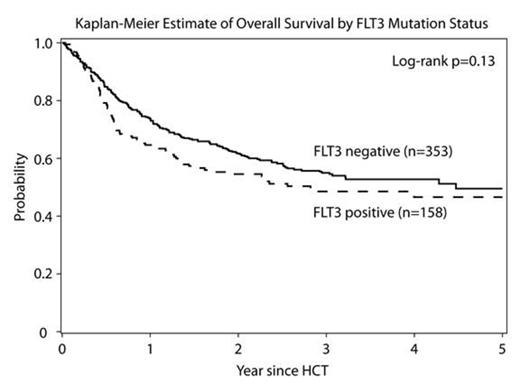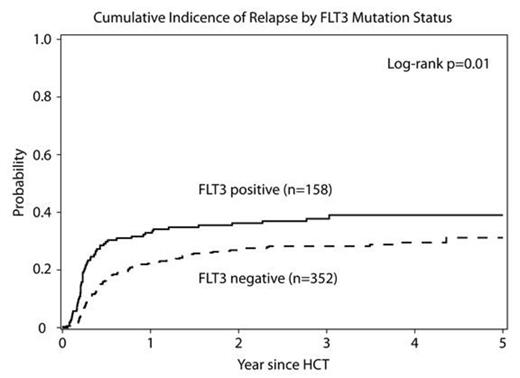Abstract
Relapse after allogeneic hematopoietic cell transplant (HCT) remains a major cause of transplant failure. Patients (pts) with FLT3 mutated acute myeloid leukemia (AML) tend to have poor prognosis and are often referred for early HCT. We studied 511 patients to determine if FLT3 mutations impact transplant outcomes.
Adults with a diagnosis of de-novo AML, with available FLT3 mutation status in first or second complete remission (CR) who underwent a human leukocyte antigen (HLA) matched sibling or unrelated donor (8/8 or 7/8) HCT after myeloablative (MAC), non-myeloablative (NMA), or reduced intensity conditioning (RIC) reported to the CIBMTR from 2008-2011 were included. Clinical outcomes following HCT for FLT3 positive and FLT3 negative AML pts were compared adjusting for significant patient-, disease-, and HCT-related variables.
511 pts met the inclusion criteria: 158 (31%) with FLT3 mutations. Median follow-up of survivors was 37 months (range, 12-65). Patient characteristics are shown in Table 1. The FLT3 mutated group had significantly higher white blood cell (WBC) count at diagnosis, more pts. with normal cytogenetics and more cycles of pre-HCT consolidation. Univariate analysis (Table 2) showed increased probability of relapse after HCT (log-rank p=0.01) in the FLT3 positive group but no significant differences in overall survival (OS) (log-rank p=0.13). There were no statistical differences in non-relapse mortality (NRM), relapse-free survival (RFS), or the cumulative incidence of acute and chronic GVHD. In multivariate analysis performed excluding the confounder WBC count at diagnosis FLT3 mutation status had a statistically significant negative effect on risk of relapse (P ≤ 0.05), but no effect on overall mortality.
We could not address the differential impact of varying FLT3 mutations or interaction of other molecular aberrations with FLT3, in addition we did not have information about post relapse interventions. Encouragingly, nearly 50% of patients with FLT3 positive AML who underwent allogeneic HCT in CR were long-term survivors after allogeneic HCT. Though associated with augmented risks of relapse, FLT3 mutation status does not adversely impact long-term survival. Pre-emptive strategies using FLT3 inhibitors after HCT may reduce relapse risk and should be studied prospectively in order to improve outcomes of these high-risk patients.
Patient Characteristics
| . | FLT3 Negative (N=353) . | FLT3 Positive (N=158) . | |
|---|---|---|---|
| Median Age (Range) | 46 yrs (18-60) | 47 yrs(18-60) | |
| Median WBC count * x109/L (Range) | 10 (<1-344) | 34 (<1-305) | |
| Cytogenetics* | Normal | 114 (32%) | 102 (65%) |
| Other | 228 (65%) | 51 (32%) | |
| Missing | 11 (3%) | 5 (3%) | |
| Disease Status | CR1 | 252 (71%) | 125 (79%) |
| CR2 | 101 (29%) | 33 (21%) | |
| Cycles of consolidations prior to HCT in CR1* | 0 | 86 (34%) | 24 (19%) |
| 1 | 71 (28%) | 49 (39%) | |
| ≥2 | 55 (26%) | 40 (32%) | |
| Missing | 30 (12%) | 12 (10%) | |
| Donor Type | 8/8 Sibling | 150 (42%) | 67 (42%) |
| 8/8 Unrelated | 165 (47%) | 70 (44%) | |
| 7/8 Unrelated | 38 (11%) | 21 (13%) | |
| Conditioning Regimen | MAC | 302 (86%) | 136 (87%) |
| NMA/RIC | 51 (14%) | 21 (13%) | |
| . | FLT3 Negative (N=353) . | FLT3 Positive (N=158) . | |
|---|---|---|---|
| Median Age (Range) | 46 yrs (18-60) | 47 yrs(18-60) | |
| Median WBC count * x109/L (Range) | 10 (<1-344) | 34 (<1-305) | |
| Cytogenetics* | Normal | 114 (32%) | 102 (65%) |
| Other | 228 (65%) | 51 (32%) | |
| Missing | 11 (3%) | 5 (3%) | |
| Disease Status | CR1 | 252 (71%) | 125 (79%) |
| CR2 | 101 (29%) | 33 (21%) | |
| Cycles of consolidations prior to HCT in CR1* | 0 | 86 (34%) | 24 (19%) |
| 1 | 71 (28%) | 49 (39%) | |
| ≥2 | 55 (26%) | 40 (32%) | |
| Missing | 30 (12%) | 12 (10%) | |
| Donor Type | 8/8 Sibling | 150 (42%) | 67 (42%) |
| 8/8 Unrelated | 165 (47%) | 70 (44%) | |
| 7/8 Unrelated | 38 (11%) | 21 (13%) | |
| Conditioning Regimen | MAC | 302 (86%) | 136 (87%) |
| NMA/RIC | 51 (14%) | 21 (13%) | |
* p ≤ 0.05
Univariate Analysis of Outcomes at 3 years
| . | FLT3 Negative (N=353) . | FLT3 Positive (N=158) . |
|---|---|---|
| Relapse * (95% CI) | 28% (24-33) | 38% (30-45) |
| Overall Survival (95% CI) | 55% (50-60) | 49% (40-57) |
| . | FLT3 Negative (N=353) . | FLT3 Positive (N=158) . |
|---|---|---|
| Relapse * (95% CI) | 28% (24-33) | 38% (30-45) |
| Overall Survival (95% CI) | 55% (50-60) | 49% (40-57) |
* p ≤ 0.05
No relevant conflicts of interest to declare.
Author notes
Asterisk with author names denotes non-ASH members.



